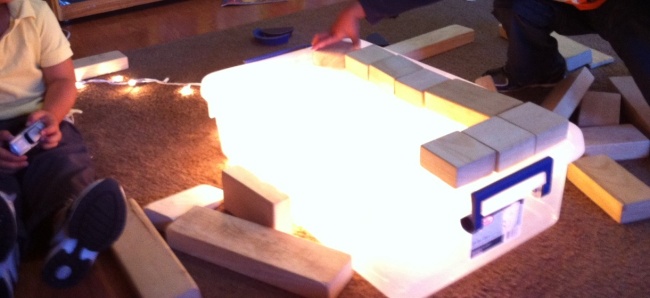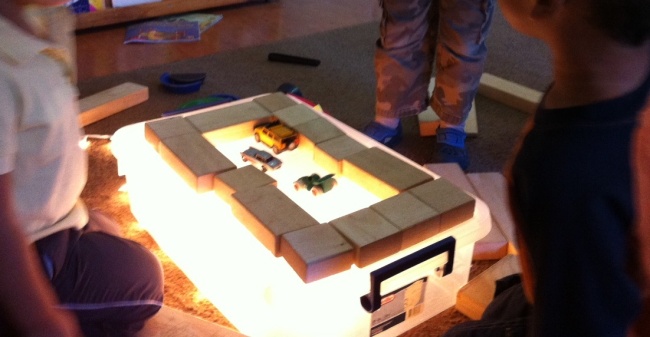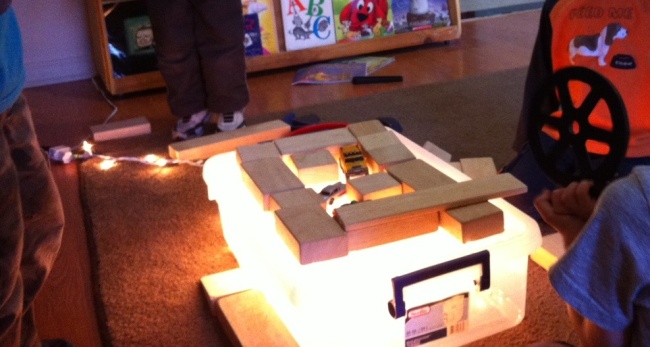Competition in the Classroom
Competition in the Classroom, By Cathy Amaral
One particular morning, I decided to set up a provocation with blocks in hopes of inspiring the children to continue or extend a structure for their cars that they have shown interest in since the beginning of the school year. Each day the children would ask to bring small cars into the classroom, and I often felt that they were competing with the cars and that it would cause conflicts that would interrupt their play. On this particular day I decided to add ramps and tubes to encourage them to explore transportation, balance and speed. The children were noticing that the blocks would not stand on the carpet so they built on top of a box. One child had suggested that they build a house for the cars and then wanted to race them inside it. I noticed he was extremely concerned with how they placed the cars to start off the race. He repeated, “I win, I win, because I got the flag before you”. The two children competed back and forth for a while until the structure was completely broken and no longer on top of the box. He then became upset. I wanted to observe how long the two would sustain this play before moving on and how long the competition would continue. For days later and leading up to recently, competition has had a very strong presence in their play. It had me looking for answers as to how to handle the situation. Was this negative or positive behaviour?
This brought me to ask, is competition healthy in the classroom?
In my research, I have discovered that competition is often indicative of a developmental stage. At this stage, children’s imaginations are still very vivid, yet their own sense of autonomy is growing, making them want to prove their abilities to the world (Levine, 2013). Research shows us that ages 3, 4 and 5 are the years where independence comes into play for a child. These are the fundamental years where children move from toilet training, into speaking in full sentences to developing their own self-image and self-esteem. We often witness children of the preschool and kindergarten ages sustaining play for longer periods of time, choosing whom they spend their time with and assigning roles to peers during these activities.
In the first weeks of school I had been making many observations of my students making these connections during play, interacting with each other and evolving their play. Not only had they begun to sustain their play for an extended period, they had begun to self-regulate. The self-regulation and autonomy however, were accompanied by a competitive nature of play. I decided to write this piece in hopes of researching the best way to approach the situation. After seeking support from colleagues, I was encouraged to blog and tweet about it since it could be a question other educators could likely relate to.
My fellow Acorn faculty members each shared their opinions and professional knowledge on the topic. Sue, who works with children of Toddler age with roots in psychology, and is very knowledgeable about child development, knew each child on an individual level. She interprets competitive behaviour as being linked to the fact that each child is the youngest of their siblings, feeling certain insecurities and a stronger need to prove themselves. She also stated, it can be linked to children’s reactions to older siblings’ experiences in competitive sports. How do they understand competition at such a young age? How much emphasis is there on winning when playing sports or games?
When I spoke with Stephanie, a Toddler teacher rooted deeply in child development, she mentioned something so deceptively simple, “It feels good to be the best”. It brought me to realize how we are often so quick to deconstruct and hinder behaviours, treating them as “incidents” that are actually true feelings and desires, simply related to human nature. “They want to prove their individuality and set themselves apart from the rest”. Stephanie witnesses these behaviours as early as 2.5 years of age, having more frequency beyond the age of 3. She also attributes this to the type of materials involved and the influences of “characters” in popular culture.
Rosanna, a Preschool teacher also with a background in child development, is firm in her stance that “competition can be healthy in moderation”. She went on to explain that believing that everyone or no one should win is not a “real world reality”. Everyone faces some form of competition at some point in his or her lives and it can be a positive feeling to achieve something based on how you have contended in a game or sport. This does not denote however, the fact that there is a time and place for competitive behaviour and that the classroom is not always the best place for such behaviour. This behaviour also speaks about gender roles and competitive behaviour in boys versus girls.
Sarah, a student completing her Bachelor of Child Development Degree shared the relation between competitive behaviour and Erikson’s Stages of Development. She believes that much like Erikson’s theory states, children at this age are developing and refining their own competencies and have a strong desire to prove themselves to the people they trust. She also related this behaviour to influences around them such as media characters and superheroes. These characters enhance children’s imaginations and help them to recreate scenarios and make accomplishments.
In my own observations, I wondered if I could help facilitate an outlet for their desire to compete to help them make sense of the feelings they were experiencing. I was noticing an intense build up of emotions that would usually result in aggression and physical behaviour. Another colleague who is an Early Learning Professional and Seneca Faculty Professor, Louise created a provocation with marbles, which they turned into their own “Marble Run”, a competitive game (while also learning about science, speed and physics). It was also a perfect opportunity to work out these competitive feelings. With this game, the children implemented elements to make it “more fair” such as a start and finish line. They competed with each other to have their marble travel the fastest and ultimately win, but in a way where it was more experimental. How could they change and enhance the set-up of the ramp to make their marbles travel faster? Experiments such as these helped them to make sense of a complex feeling of gratification that was extremely difficult for them to understand and explain in words, but also how to show fairness when playing with each other.
With this inquiry of my own, my goal was to shed light on an issue that could be all too common, yet obscured. We know that these behaviours are present in our classrooms, but how do we approach them? It seems to me that the answer lies in the notion of taking a step back and thinking over our reactions to natural emotions before we immediately associate them negatively. We need to ask ourselves, what are they really telling me? In this particular situation, though I may have wanted to rid the classroom of competitive behaviours all together, there was an underlying message that the children were trying to convey about a feeling that they needed to work out. Believing in that strong Image of the Child, I realized, it was not about solving a “problem” in my classroom, but I had to listen.
Cathy Amaral, BA, B.Ed, OCT, Kindergarten Teacher at Acorn School
Work Cited
Levine, K. (2013, September). Why kids are competitive. Parents Magazine, Retrieved from http://www.parents.com/kids/development/behavioral/why-kids-are-competitive/?page=1




loved reading this, and I see the competetion within certain children in my liitle group too. so I amlooking forward to sharing this with my colleague as a basis for a discussion as to how we can meet the negative side of the compettion that raises its ugly head every now and then…
I little comment… I found the text a little hard to read with the grey against the jars (love the jars) I wondered if it was possible to make the text darker and more easier to read for my poor aging eyes!!
all the best, Suzanne
fabulous so much easier… just about to link this post to one I am writing at the moment…
Pingback: Competition in the Classroom | Early Childhood ...